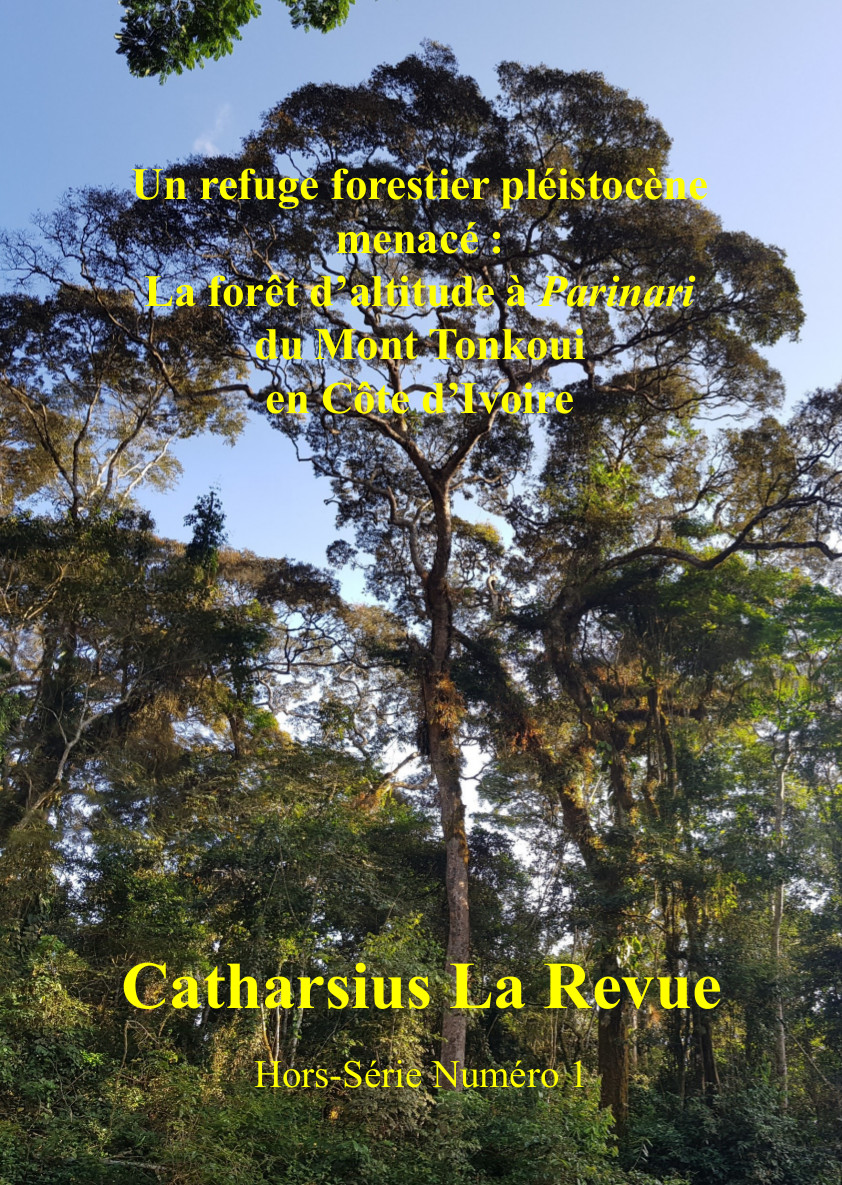Philippe MORETTO, Bertrand COSSON, Hitoshi TAKANO, Patrick BASQUIN, Patrice BORDAT, Stéphane BOUCHER, Thierry BOUYER, Samuel DANFLOUS, Violette DÉROZIER, Ulf EITSCHBERGER, Pierre JUHEL, Étienne LEROY, Pol LIMBOURG, Bruno MASSA, Jean-Yves MEUNIER, William MILES, Eylon ORBACH, Gérard ROBICHE, Sébastien ROJKOFF & Guy SILVESTRE.
A threatened Pleistocene refuge: the upland Parinari forest of Mont Tonkoui in Côte d’Ivoire. Evaluation of the entomological biodiversity. Conservation values of the site
Catharsius la Revue, hors série N° 1. 1-122 (including a map, 24 plates and 27 figs.).
Introduction. Since 2015, the Association Catharsius (http://www.catharsius.fr) and the African Natural History Research Trust (ANHRT. https://www.anhrt.org.uk) have undertaken regular research expeditions to Côte d’Ivoire, and in particular to the classified forest of Mont Tonkoui where data on the entomological fauna of this isolated massif has been amassed. In 2016 we drew the attention of Francis LAUGINIE † (founder of Afrique Nature International), who had invested so much in conserving the nature of Côte d’Ivoire, to the unique and exceptional diversity of this site. Following this meeting, the classified forest of Tonkoui was included in a list of sites destined to acquire Natural Reserve status, but conservation is difficult without knowing what to conserve. At this stage, it seemed necessary for us to support these steps taken to reinforce the protection of Mt Tonkoui by presenting a synthesis of our knowledge of this unique massif, the most southerly of the Guinean Highlands. Contrary to normal practice, emphasis will be placed on the entomological fauna and the lists of species published in the appendix are original contributions. We hereby wish to highlight the lack of insect groups included in biodiversity assessments (Troudet et al., 2017), especially in tropical regions (Titley et al., 2017) where the preservation of sites with high biodiversity can be neglected simply due to “trendy” umbrella species not being represented in inventories. In addition to the insects, we will produce an actualized list of plants, a first list of birds, and will highlight interesting species belonging to other orders known from Tonkoui. Although the site is not subject to logging, we have chosen to present this work as an evaluation of the High Conservation Values (HCV) thereby showing that Tonkoui is a natural environment with remarkable biodiversity and notable ecological and socio-cultural functions. This methodology, although unusual for a scientific publication, seemed appropriate for strengthening the protection level of this massif. We will therefore address the six HCV criteria in turn as defined by the Forest Stewardship Council (FSC), drawing inspiration from the approach implemented by Daïnou et al. (2016). Along the way, we will show that this "hotspot" of Ivorian entomology is a true Pleistocene refuge sheltering Gondwanan lineages. We will also show that the primary West African upland Parinari excelsa Sabine forest and the montane savannah on granite outcrops that occupy the upper part of the mountain are two rare and endangered environments that urgently need protection. We will see that four of the six HCV as defined by the FSC apply to Mt Tonkoui, thus providing strong justification for its protection. Finally, we will try to suggest plans for the management of what we hope will become the future Réserve Naturelle du Mont Tonkoui.
Key words. – Côte d’Ivoire, Mont Tonkoui, Guinean Highlands, pleistocene refuge, biogeography, faunistics, endemism, upland Parinari excelsa forest of West Africa, mountain savanna, HVC, FSC, threats, preservation, Insecta, Coleoptera, Scarabaeoidea, Scarabaeidae, Aphodiidae, Cetoniidae, Dynastidae, Rutelidae, Lucanidae, Passalidae, Brentidae, Cerambycidae, Tenebrionidae, Lepidoptera, Rhopalocera, Sphingidae, Saturniidae, Lasiocampidae, Orthoptera, Mantodea, Aves, Plantae.
